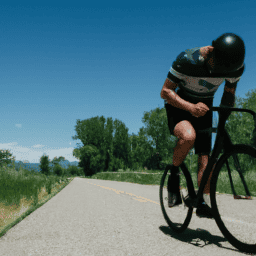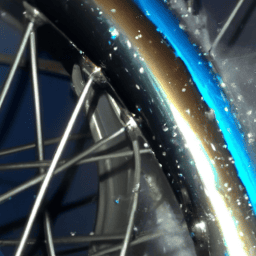As someone passionate about cycling, I’ve collected several old bikes throughout the years. Although they mean a lot to me emotionally, they are occupying precious space in my garage. I recognize that it’s time to let them go, yet I’m uncertain about the best place to sell them.
Luckily, there are several options available, each with their own benefits and drawbacks. One option is to sell my old bicycles online. Online marketplaces like eBay and Craigslist allow me to reach a wide audience and potentially sell my bikes for a higher price. However, the process of listing and shipping the items can be time-consuming and may require some technical know-how.
Another option is to visit local bike shops and see if they’re interested in buying my old bicycles. While I may not get top dollar for them, the process is quick and easy, and I’ll be supporting a local business.
These are just a few examples of the various options available for selling old bicycles.
Key Takeaways
- Online marketplaces, local bike shops, social media platforms, classified ads, and garage sales are all options for selling old bicycles.
- Each option has its own benefits and drawbacks, such as wider audiences and potentially higher prices on online marketplaces, quick and easy selling options at local bike shops, and the potential for more serious buyers at garage sales.
- Tips for selling old bicycles include including clear photos and descriptions, pricing realistically, cleaning and polishing the bike, researching similar bikes’ prices, and meeting potential buyers in public places.
- Negotiating prices with local bike shops can potentially save money, but it’s important to avoid being too aggressive and to do research beforehand.
Online Marketplaces
If you’re looking to sell your old bicycle quickly and easily, online marketplaces like eBay or Craigslist can be a great option. With eBay, you can list your bike for sale and have it visible to millions of potential buyers. You can also set a reserve price to ensure that you get the amount you want for your bike.
Craigslist, on the other hand, allows you to list your bike for free, and you can sell it to a local buyer without having to worry about shipping.
There are, however, some pros and cons to using online marketplaces. One of the pros is that you can reach a large audience, which increases the chances of selling your bike quickly. A con is that there are scammers on these platforms who may try to take advantage of you. Therefore, it’s important to follow safety tips, such as only accepting payment in cash or through a secure payment platform.
Transitioning to the next section about local bike shops, these shops can also be a great option if you prefer to sell your bike in person.
Local Bike Shops
When it comes to selling my old bicycle, I find that local bike shops offer several benefits. Firstly, they’re more likely to give me a fair price as they understand the value of the bike and any upgrades I may have made.
Secondly, I can avoid the hassle of listing my bike online and dealing with potential buyers. To find local bike shops, I usually search on Google Maps or ask for recommendations from fellow cyclists.
When negotiating prices with the shop, I make sure to do my research beforehand and have a realistic expectation of what my bike is worth.
Benefits of Selling to Local Bike Shops
Selling your old bicycle to a local bike shop not only benefits you financially, but it also supports a small business in your community. Building relationships with local bike shops can be advantageous in the long run as they may offer discounts or special deals for repeat customers.
Moreover, selling to a local bike shop can give you a sense of pride and satisfaction, knowing that you’re contributing to the growth of a small business in your community. Small businesses play a vital role in the community, and supporting them can have a positive impact on the local economy.
By selling your old bicycle to a local bike shop, you help keep the money circulating in your community. Additionally, local bike shops often have knowledgeable staff who can offer valuable advice on maintenance and repairs.
If you’re not sure how to find local bike shops, read on to learn more.
How to Find Local Bike Shops
To locate nearby bike shops, you can use various online tools like Google Maps or Yelp to find the ones closest to you. Once you have a list of potential bike shops, consider reaching out to your local cycling community through networking events or word of mouth referrals to get recommendations. This can help you narrow down your list and find shops that have a good reputation for fair prices and quality service.
When researching bike shops, be sure to check their hours of operation and any customer reviews or ratings available online. You may also want to look for shops that specialize in repairing or selling the type of bike you own.
By doing your research and reaching out to others in your community, you can find a local bike shop that meets your needs and budget. Next, we’ll discuss how to negotiate prices with these shops.
Negotiating Prices with Local Bike Shops
If you want to save some cash, try haggling with your neighborhood bike shop for a better deal on your new ride. One of the most effective ways to negotiate is through role playing. Before you go into the shop, practice your negotiation skills with a friend or family member. Have them play the role of the salesperson and try to sell you a bike at full price. Then, switch roles and practice your negotiation tactics. This will help you feel more confident when you actually enter the shop.
When negotiating with a bike shop, it’s important to avoid common mistakes. One of the biggest mistakes is being too aggressive. Remember that the salesperson is also trying to make a living and has a set price they need to sell the bike for. Be respectful and courteous throughout the negotiation process.
Another common mistake is not doing research beforehand. Make sure you know the fair market value of the bike you want to buy so you can make a reasonable offer. By avoiding these mistakes and practicing your negotiation skills, you can potentially save hundreds of dollars on your new ride.
And if negotiation isn’t your thing, don’t worry – there are other ways to find a good deal, such as checking social media.
Social Media
Hey, have you considered checking out social media to unload that old bike of yours? It’s a great way to reach a wider audience and potentially make some extra cash.
Social media strategies can be a game changer when it comes to maximizing your reach and increasing the chances of finding a buyer for your old bike. One of the best social media platforms to use for selling bikes is Facebook Marketplace. It’s free to use, easy to navigate, and reaches a large audience.
Make sure to take good quality photos of your bike, write a detailed description, and set a reasonable price. You can also join local buy/sell/trade groups or cycling groups to post your listing and increase your chances of finding a buyer. Another tip is to share your listing on your personal Facebook page and ask friends and family to share it as well.
If social media isn’t your thing, another option is to use classified ads. But before we dive into that, let’s explore another option for selling your bike: consignment shops.
Classified Ads
When it comes to selling my old bicycle, I’ve found that using classified ads has been a great option. Not only is it cost-effective, but it also gives me a wider reach to potential buyers.
Some popular classified ad platforms that I’ve had success with include Craigslist, Facebook Marketplace, and OfferUp.
To write an effective ad, I make sure to include clear photos, a detailed description, and a reasonable price.
Benefits of Using Classified Ads
You’ll love how easy it is to connect with local buyers and get top dollar for your old bicycle by using classified ads. There are many advantages of Craigslist ads, and the target audience for classified ads is anyone looking to sell their used items, including bicycles.
Here are some benefits of using classified ads when selling your old bicycle:
-
Convenience: You can post your ad from the comfort of your own home, and potential buyers can contact you directly through email or phone.
-
Targeted audience: Classified ads are often posted on websites that are specifically designed for buying and selling used items, so you know that your ad is reaching people who are interested in purchasing a bicycle.
-
Cost-effective: Many classified ad platforms offer free or low-cost posting options, which means you can sell your bicycle without spending a lot of money on advertising.
-
Local connections: Classified ads are a great way to connect with buyers in your local area, which means you can avoid the hassle and expense of shipping your bicycle to a buyer in another state or country.
Using classified ads is a smart choice when selling your old bicycle. However, with so many popular classified ad platforms available, it can be difficult to decide which one to use. Let’s explore some of the most popular platforms in the next section.
Popular Classified Ad Platforms
Looking for the perfect platform to pedal your bicycle to a new owner? Let’s explore the most popular classified ad platforms.
First on the list is Craigslist, the go-to platform for buying and selling items locally, including bicycles. With its user-friendly interface and extensive reach, Craigslist is a great choice for sellers looking for alternative selling options. However, it’s important to exercise caution when dealing with potential buyers on Craigslist. Always meet in a public place, preferably during the day, and bring a friend or family member for safety.
Another popular option is Facebook Marketplace, which offers a similar local selling experience as Craigslist, but with the added benefit of being connected to your social network. This makes it easier to sell to friends or acquaintances, or to vet potential buyers through mutual connections. As with any online platform, it’s important to consider safety considerations for online sales, including verifying the buyer’s identity and payment method before completing the transaction.
With these popular classified ad platforms, selling your old bicycle has never been easier.
But how do you ensure your ad stands out from the rest? Stay tuned for tips on writing effective ads.
Tips for Writing Effective Ads
To ensure your ad catches the eye of potential buyers, it’s crucial to use attention-grabbing language and highlight the unique features of your bike. Creating catchy headlines is the first step in this process.
Your headline should be short and to the point, yet intriguing enough to make someone want to click on your ad. Try using descriptive language that highlights the best features of your bike, such as ‘Vintage Schwinn Cruiser – Perfect for Summer Rides!’ or ‘Lightweight Carbon Fiber Road Bike – Ideal for Racing Enthusiasts!’
Once you’ve grabbed the reader’s attention with your headline, it’s important to craft persuasive language that will convince them to take a closer look at your bike. Start by providing a brief description of the bike’s make, model, and year. Then, highlight any unique features that set your bike apart from others on the market, such as a custom paint job or upgraded components.
Finally, be sure to include clear, high-quality photos of the bike from several angles to give potential buyers a better idea of what they’re getting. With these tips, you’ll be well on your way to crafting an effective ad that will help you sell your old bike quickly and easily.
When it comes to selling old bikes, garage sales can be a great way to make a quick sale.
Garage Sales
If you’re planning a garage sale, why not include your old bicycle as a sale item? Garage sales are a great way to get rid of items you no longer need while making a little extra cash on the side. When it comes to selling your old bicycle, there are a few tips for pricing and attracting buyers that you should keep in mind.
Firstly, make sure you price your bicycle realistically. Do some research beforehand to see what similar bikes are selling for online or in local bike shops. You don’t want to price it too high and turn off potential buyers, but you also don’t want to sell it for too little and miss out on potential profit. Secondly, make sure you clean and polish your bicycle before putting it up for sale. A little bit of elbow grease can go a long way in making your bike look more appealing to potential buyers. Lastly, make sure to display your bike prominently at your garage sale. Put it in a high-traffic area and make sure it’s easily visible to anyone passing by. By following these tips for pricing and attracting buyers at your garage sale, you can increase your chances of selling your old bicycle quickly and for a fair price.
| Pros | Cons |
|---|---|
| Great way to get rid of items you no longer need | You may not attract as many serious buyers compared to other selling methods |
| Can make a little extra cash on the side | You may not get the best price for your item |
| Can be a fun social event with friends and family | You may have to deal with haggling and negotiating with buyers |
Overall, garage sales can be a great way to sell your old bicycle and other items you no longer need. Just remember to price your bicycle realistically, clean and polish it before putting it up for sale, and display it prominently at your garage sale. By doing so, you can increase your chances of making a successful sale and freeing up some space in your home.
Frequently Asked Questions
What is the best way to determine the value of an old bicycle before selling it?
Determining the value of an old bicycle can be tricky. I recommend researching similar bikes that have recently sold online and taking note of any unique features. This can help you set a fair pricing strategy when selling.
Can I sell a bicycle that needs repairs or is it better to fix it first?
When deciding whether to repair or sell your old bicycle, weigh the pros and cons. If repair costs exceed the bike’s value, selling it as is might make sense. Alternatively, consider donating it or repurposing it for alternative uses.
Are there any legal requirements or paperwork needed when selling a used bicycle?
Funny you should ask, I just sold my old bike last week! Legal considerations are minimal, but liability concerns can arise. Make sure to document the sale with a bill of sale and disclose any known issues.
How can I ensure my safety when meeting with potential buyers?
When meeting potential buyers, I always prioritize my safety by choosing a public meeting place and trying to get a sense of their background through conversations. It’s important to trust your instincts and take precautions to ensure a smooth and secure transaction.
What is the best way to negotiate the price when selling a used bicycle?
When negotiating the price of a used bicycle, I use a few key strategies. I research the average price for similar models, highlight any upgrades or repairs, and am willing to compromise. Tips: be confident and don’t be afraid to walk away.
Conclusion
All in all, selling an old bicycle can be a profitable and straightforward process once you know where to look. I highly recommend online marketplaces like eBay or Craigslist, local bike shops, social media platforms, classified ads, and garage sales as great options to consider.
However, it’s important to remember that no matter where you choose to sell your bike, patience and persistence are key. Just because it doesn’t sell right away doesn’t mean it won’t sell at all. As the saying goes, ‘good things come to those who wait.’
So take your time, do your research, and don’t be afraid to negotiate with potential buyers. With a little effort and a bit of luck, you can turn that old bike into some extra cash in your pocket.









